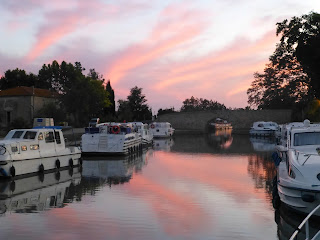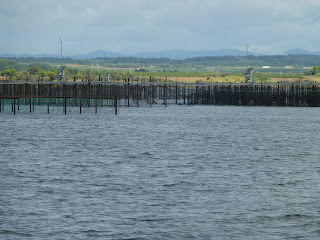 |
| Capestang |
As I write I am looking through the bridge hole of the famous Capestang Bridge. And an exceedingly small bridge hole it is too. I say 'famous' but really only to canal travellers. The dimensions of this bridge have caused thousands of words to be written on forums and blogs (and yes, I'm aware I'm adding to them), diagrams drawn and boats measured and modified. The burning question being 'will we fit through?' Judging by the gouges and scrapes on the underside of the arch the answer to that in some cases was, 'not quite.' Anyway we shall see how we go later today. We've given l'Avenir as low a profile as we can by taking off the windscreen and lowering the navigation frame, canopy and mast. The only thing left we can do is duck.
(Speaking of ducks the ones around here must be the noisiest in France. Perhaps it's not hunting season here as yet.)
 |
| La Maguellonne |
Since my last post we have travelled through yet another completely different and rather beautiful landscape. The canal de Rhone a Sete terminated, for us, in the Etang du Thau, the second largest inland lake in France and the cause of a few worries for me, it being another source of horror stories so beloved of bloggers. Before we reached there though we had a few days where the canal has just low, narrow dykes separating it from large etangs (lakes) on both sides. Every so often there would be tiny hump backed bridges giving access to the etangs for the fishermen in their small boats. Occasionally a small boat would shoot out at speed across our bows from one lake to the other.
To the south of us lay the Mediterranean. Near Frontignan it is only a stroll through the sand dunes. This is a favourite area for naturists but it was much too cool and windy for us to consider a stop there - my excuse anyway. We had stopped for our Mediterranean sojourn at La Maguellonne where there are 3 wooden pontoons just before the passerelle.
 |
| La Maguellonnne |
 |
| Passerelle (footbridge) La Maguellonne |
This floating footbridge gives access to a nature reserve and abbey and is also a favoured entry point to kilometres of beaches. In summer thousands of pedestrians and cyclists cross this bridge every day. When a boat wishes to pass the bridge operator starts an engine and the bridge swings open at high speed. It closes at high speed too so no hanging around.The beach is about a kilometre and a half's walk or, in summer, you can take the 'Petit Train' (a little tourist train) for free.
You are allowed to stay on the pontoons for free for 3 days but one day at the beach for a splash in the warm and surprisingly (to me) big surf was plenty. The wind was getting stronger and the Etang du Thau lay ahead.
Our last stop before the etang was the town of Frontignan which has a rather dilapidated lifting bridge which opens only twice a day (to try to prolong the mechanism- one day it will give up the ghost which will be interesting). We missed the 4pm opening so moored for the night on the 'wrong' side ie the side with no water, electricity and the gypsy encampment. As the evening drew on quite a few other boats joined us. From about 7.30 in the morning people started to get ready for the bridge lift at 8.30. I've no idea why as it was only 50 metres in front of us. By 8.15 one boat was up at the bridge itself determined to be first through. Perhaps, we thought, he wanted a good mooring spot on the other side. Then the bridge began its slow lift, the traffic light staying stubbornly red until it was at its full height. Then we were all off! It was like some mad race start.The bridge allows for possibly 2 boats to pass if they go at a sensible speed but it was all a bit chaotic. Of course there were boats on the far side of the bridge trying to get through and others who were trying to get off their mooring and cross over the canal to join the queue. Strangely, none of the boats from our side who'd been so eager for 'the off' stopped. Once through the chaos they settled down to a snails pace and it took us an hour to get to the etang entrance where they all suddenly stopped and tied up. Perhaps, like me they were having second thoughts. The sky was grey, the water choppy and it was feeling pretty breezy.
 |
| Etang du Thau |
 |
| Oyster beds |
The etang is about 22km in length and because it is shallow it can rapidly become difficult to navigate in strong winds which can blow up quite suddenly. Being a worrier I had been consulting wind sites (Google is lifeblood to the panickers amongst us) and I have to say that forecasters change their minds as rapidly as the weather itself. So, not much use. Standing on deck it was clear to me that the wind was getting windier but having come an hour to reach the etang we were not inclined to turn back. So, we put the foot down and ventured forth.
The channel will be well marked said he on the helm. Yeah, right. The first ones are but after that good binoculars and a a bit of guesswork are required. There are vast oyster beds along the north side which were as helpful for orientation as the few and far between channel markers. There are a few ports along the etang and by all accounts they are very pretty and worth visiting but, in deferernce to my desire to get off the etang, we decided to make for the final one, Marseillan. And what a lovely port that turned out to be. Expensive but very pretty and with lots of restaurants serving delicious seafood. Oysters straight form the etang - delicious.
We stayed for a couple of days and then back out onto the etang for the brief dash around the corner to the entrance to the Canal du Midi.
 |
| Marseillian |





